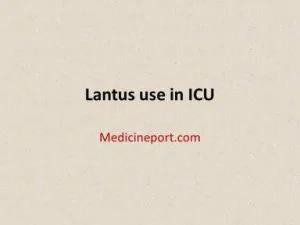Lantus is a long-acting insulin analogue also known as insulin glargine. Lantus use in ICU is described in detail here.  Similar to human insulin, it is produced using recombinant DNA techniques.
Similar to human insulin, it is produced using recombinant DNA techniques.
Insulin glargine substitutes glycine for asparagine at position A21 of the insulin molecule and adds two arginine molecules at position B30.
The isoelectric point of insulin glargine is close to a pH of 7.0. Altering these amino acids makes insulin glargine precipitate in subcutaneous tissue. Zinc is added to stabilize intrahexamer contact to prolong activity.
 Lantus use in ICU is as subcutaneous depot injection. The onset of action is 2 to 4 hours. There is no peak action. The duration of action is 20 to 24 hours.
Lantus use in ICU is as subcutaneous depot injection. The onset of action is 2 to 4 hours. There is no peak action. The duration of action is 20 to 24 hours.
With a long duration of action, Lantus lends itself to once-a-day dosing in the morning an attractive formulation for those not critically ill.
Lantus use in ICU is only as a basal insulin replacement. Prandial insulin requirements should be covered with short-acting insulin and the patient should be followed closely as insulin needs often decrease as patients become less ill.
 Lantus use in ICU should not be in those in whom blood glucose levels may vary greatly (e.g., critically ill patients whose levels may fluctuate as pressors are titrated and sepsis occurs) or in whom interruption of parenteral nutrition and tube feeds may occur (as it does in virtually all ICU patients for many reasons).
Lantus use in ICU should not be in those in whom blood glucose levels may vary greatly (e.g., critically ill patients whose levels may fluctuate as pressors are titrated and sepsis occurs) or in whom interruption of parenteral nutrition and tube feeds may occur (as it does in virtually all ICU patients for many reasons).
It should be noted that in critically ill patients, the long duration of Lantus use in ICU can cause profound hypoglycemia without concomitant administration of glucose calories.
For further reading:
